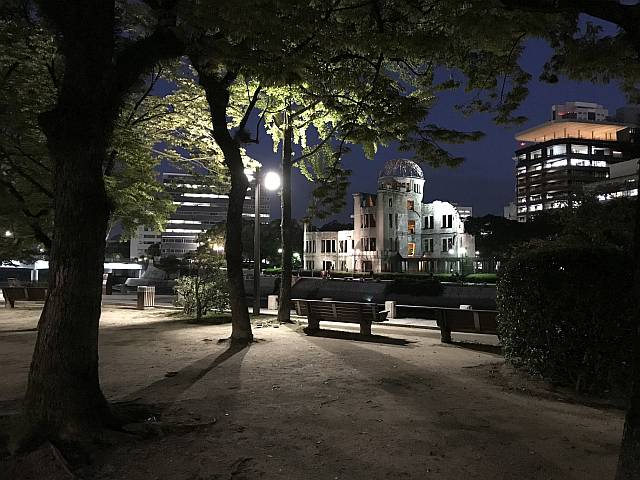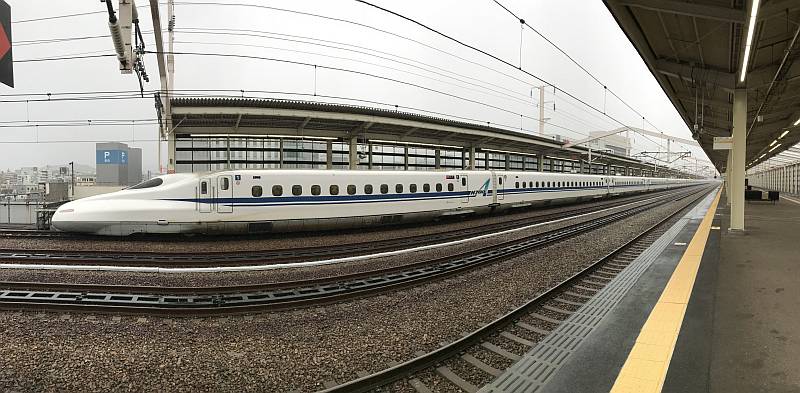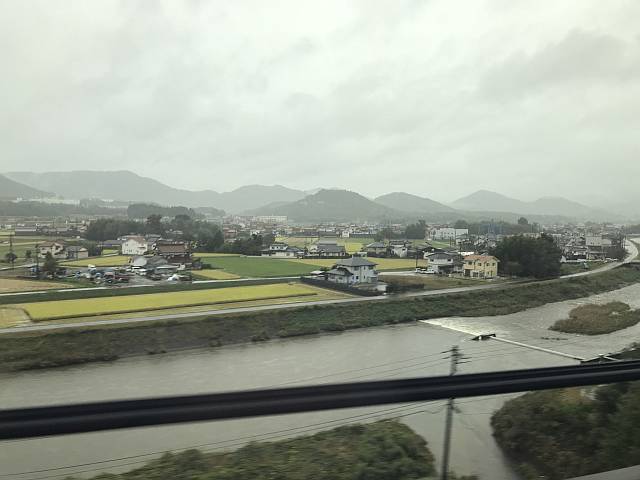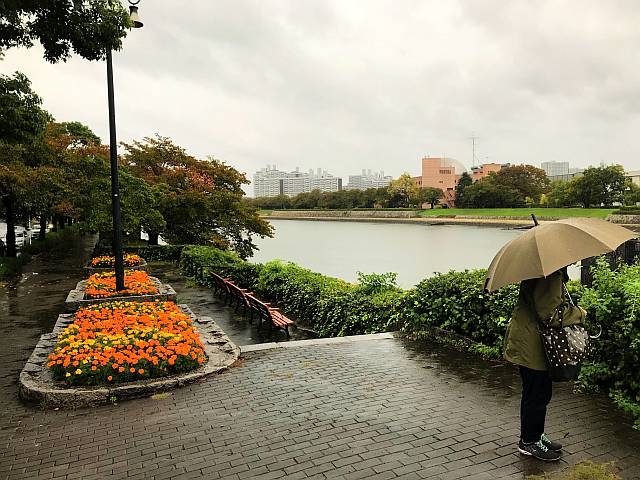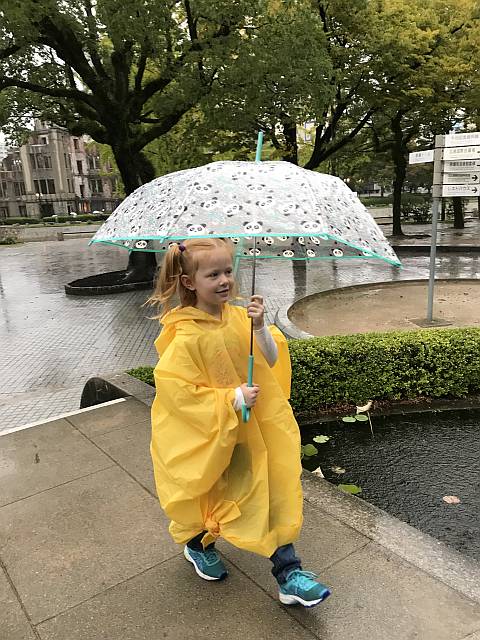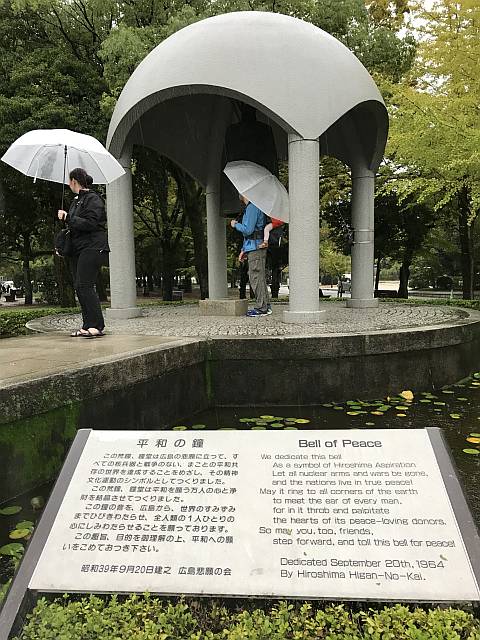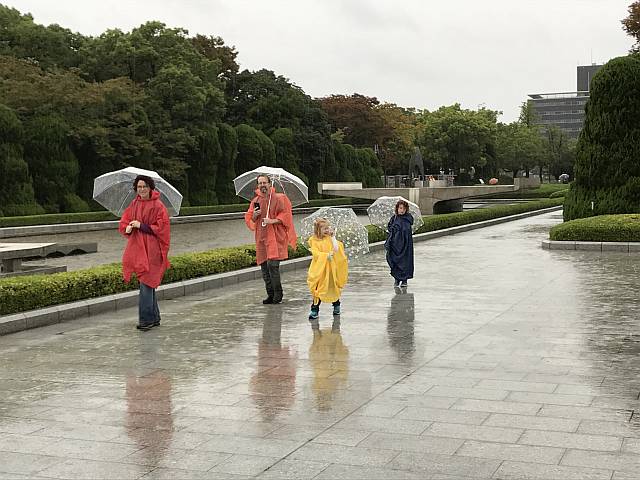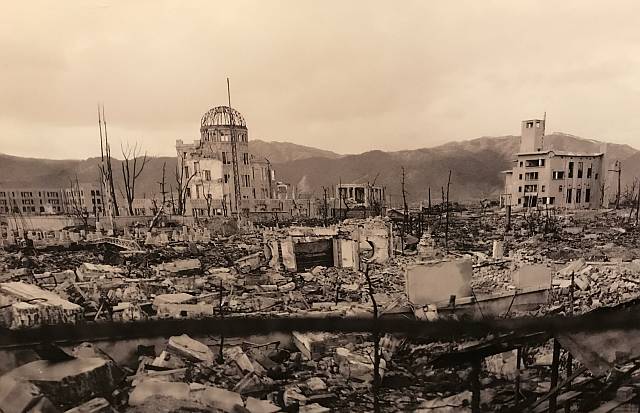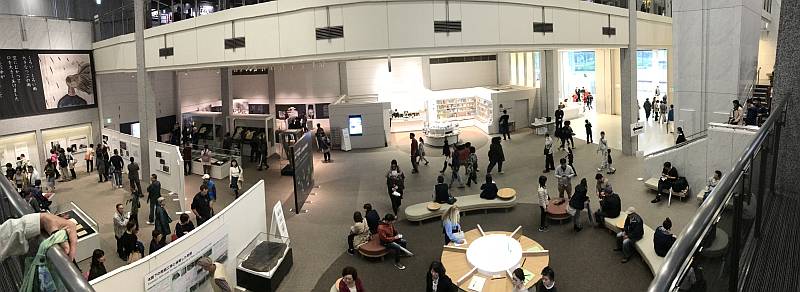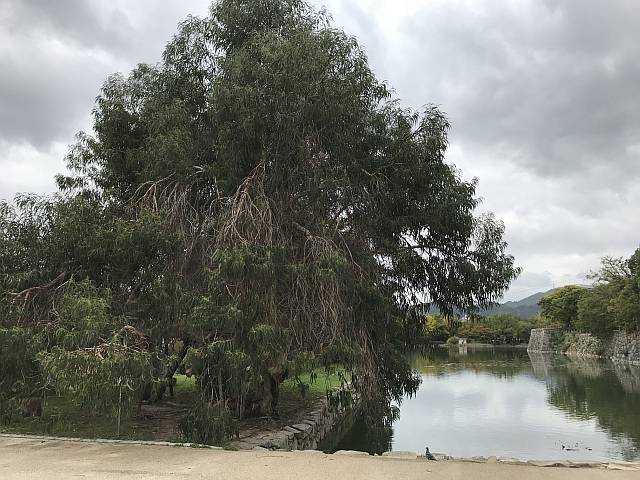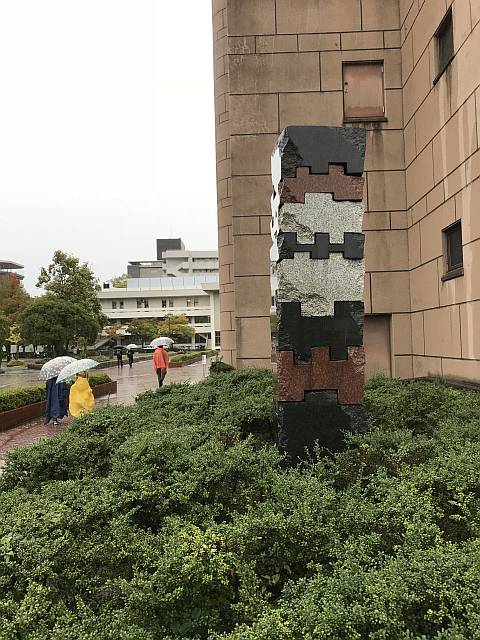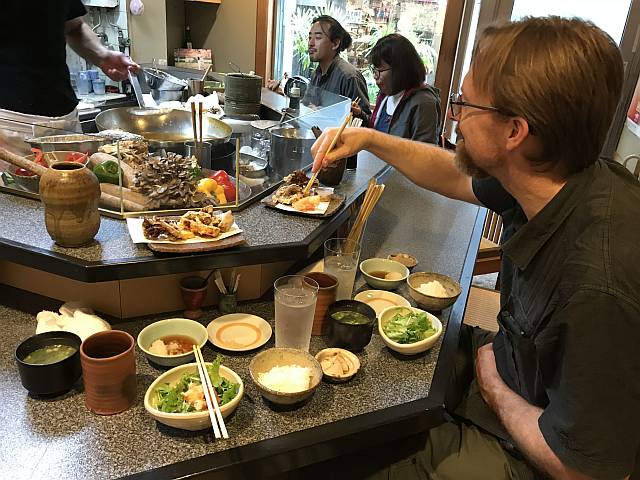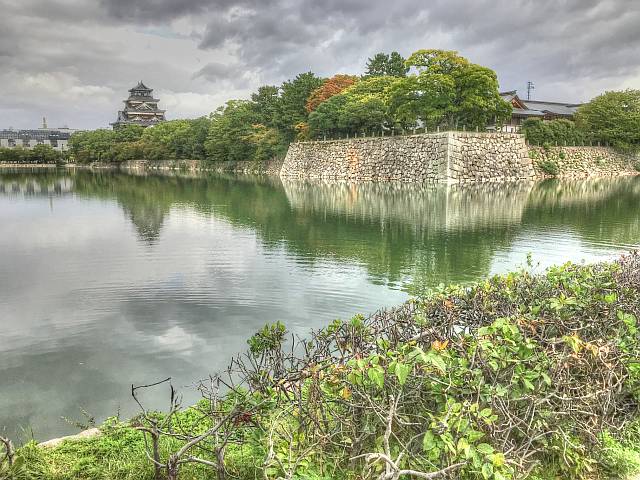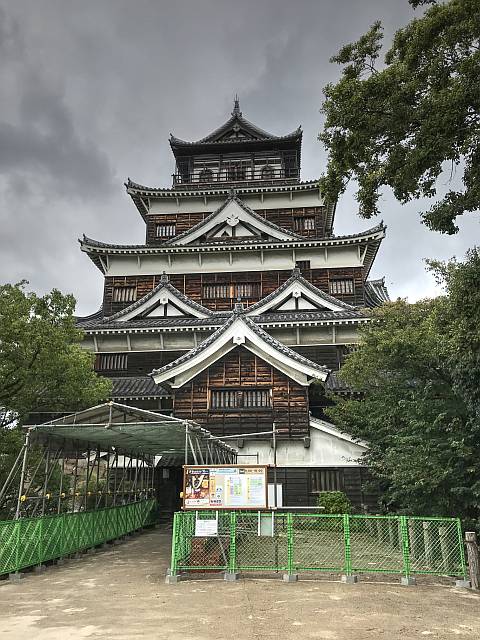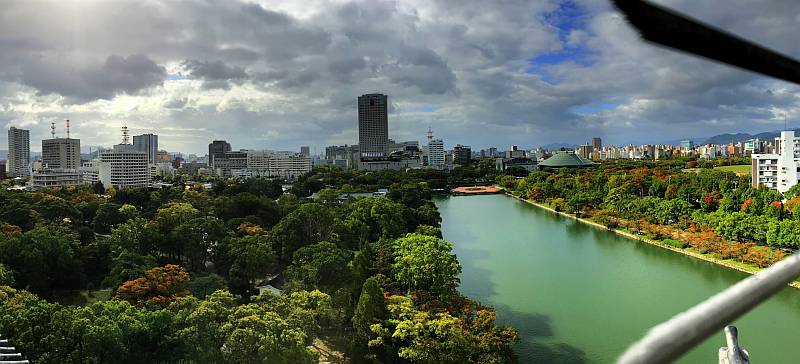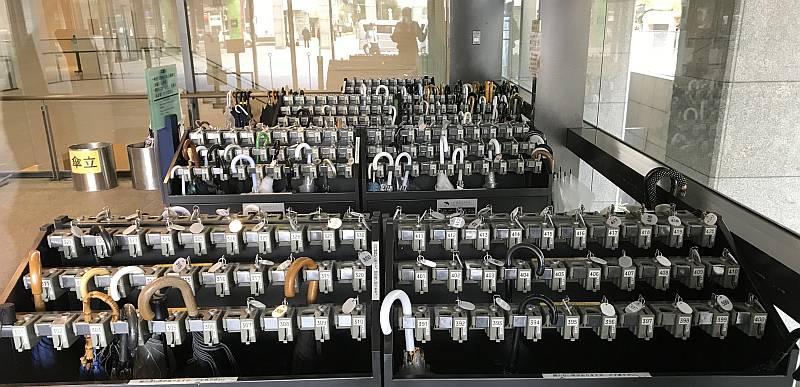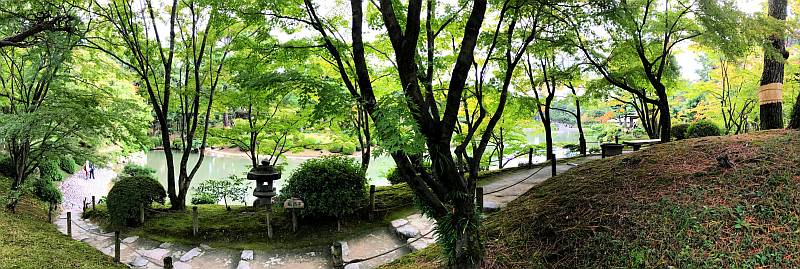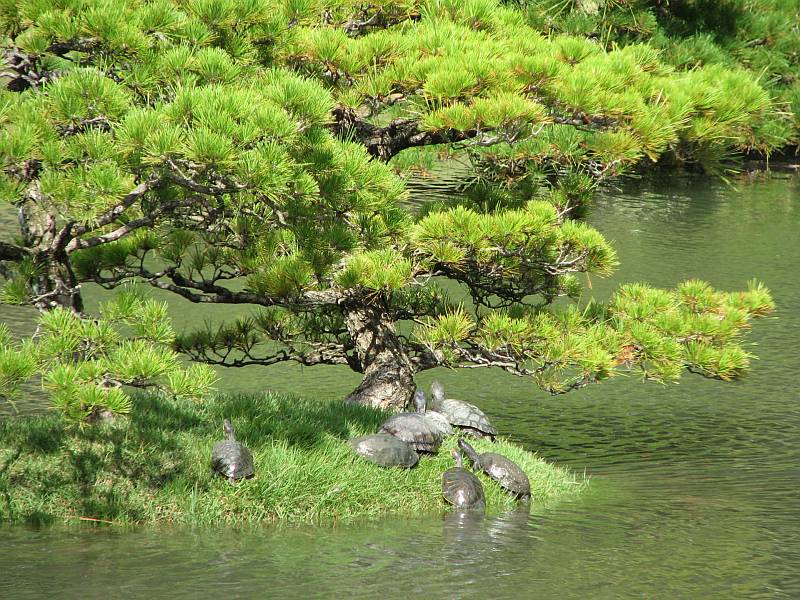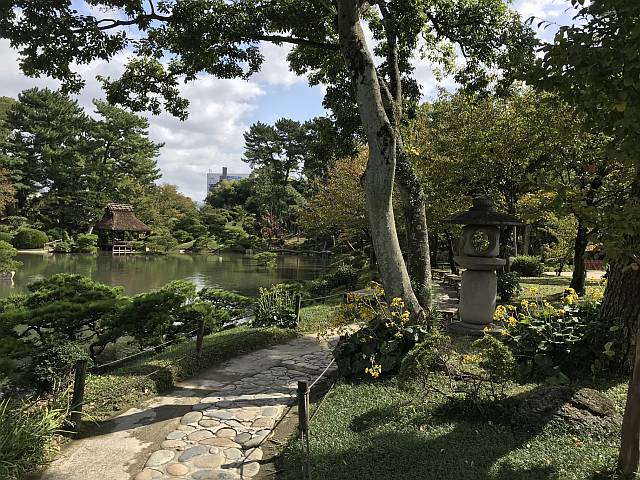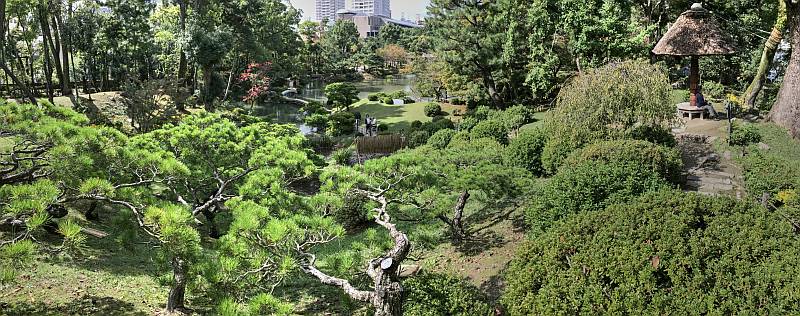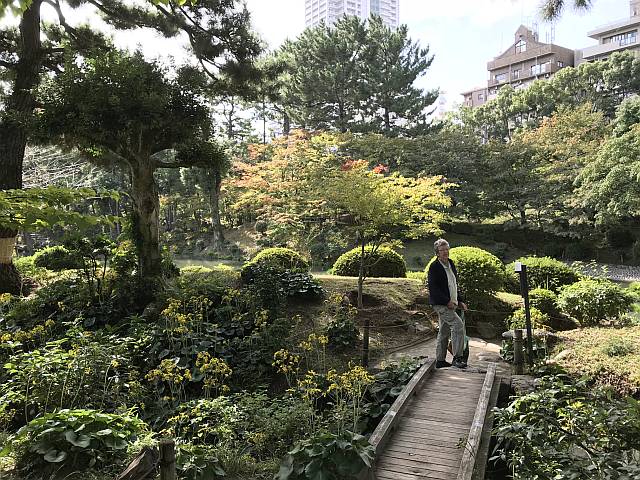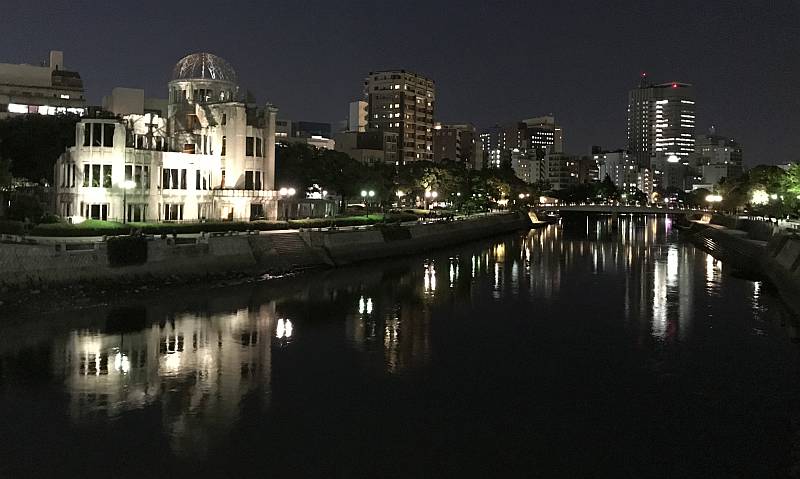Hiroshima is best known to people outside of Japan as being the first city
in the world ever to be bombed with a nuclear weapon.
The Peace Dome (photo on the right) is the remains of one of the few buildings near the hypocentre (the point directly below the bomb when it exploded) that partially survived.
(Everyone in the building was killed instantly, and the building burned after the bomb.)
There is an excellent museum and memorial in the spacious Peace Park on an
island in the Motoyasugawa River across from the Peace Dome.
These are far from being the city's only attractions, it also has an excellent
traditional
garden and a good
castle.
The rain, from Typhoon Lan, that fell while we visited Hemeji Castle
continued for more than the first 24 hours that we had in Hiroshima.
Photo taken 2017/10/23
I took this panorama of a Shinkansen (Japanese bullet train) while waiting
for another Shinkansen to take us from Himeji to Hiroshima.
Shinkansen had either eight or 16 carriages and the carriage numbers for both
were marked on the station platforms so that passengers could wait in exactly
the right place to enter the carriage that they were booked on when the
train arrived.
This was useful particularly because, at the more minor stations in particular,
the train would have a very brief stop.
Note the long, tapering nose.
I suspect that this is for several reasons, one of which being the need to
not produce a pressure wave that would impact trains travelling in the
oposite direction.
(As mentioned under
trains in the Random Observations section of these pages, more standard trains that travelled at lower speeds had blunt noses and when one passed another there was a very noticeable 'thump' as the pressure wave was encountered.)
Photo taken 2017/10/21
View from a Shinkansen between Himeji and Hiroshima.
There are several things about this view that make it typical of many that
we saw:
- There was a combination of flat, 'developed' land and steep, forested
hills (As mentioned under
geomorphology in the Random Observations section, most of the land we saw in Japan was one or the other type, there was little in between);
- There was farm land, but there were also many houses in the same view, farm land without houses in view was rare;
- Rivers were often seen, no doubt because of the (relatively to Australia)
wet climate and the fact that railways make use of valleys as the easiest
place for construction;
- The weather was overcast.
It had rained steadily most of the day to this time, and it continued to rain all the next day, due to typhoon Lan; but in the three weeks we had in Japan we didn't get a lot of sunshine.
Photo taken 2017/10/21
A splash of bright colour by the Motoyasugawa River on a dull, rainy day.
There is little wasted space in most Japanese cities, land not covered with roads, paths or buildings usually were gardened.
Typhoon Lan was responsible for all-day rain; although I found the lack of
wind very surprising.
Apparently the worst of the typhoon stuck further north than Hiroshima.
Photo taken 2017/10/22
Beth's raincoat was a bit big for her.
The Peace Dome is in the background.
Photo taken 2017/10/22
The Hiroshima Bell of Peace.
There are other Bells of Peace around the world, including one in
Cowra, NSW, Australia.
The bell itself is behind and above Ken, not easy to see.
Claire is on the left, Adelaide is on Ken's back.
Photo taken 2017/10/22
We had a lot of rain while in Japan, this was perhaps the wettest day of all.
In Australia most people do not carry umbrellas; in Japan umbrellas are an
essential.
The rain made photography challenging; holding onto an umbrella at the same
time as composing a photo and keeping the rain off oneself and one's camera
is not easy.
Luckily, there was little wind with the rain.
Julia, Shayne, Beth and Anna at the Peace Park, Hiroshima.
Photo taken 2017/10/22
There is an excellent war memorial and museum in the Peace Park.
This photo, which includes what was to become the Peace Dome, was taken shortly after the nuclear bomb was dropped.
A panorama of a part of the Peace Park Museum
Photo taken 2017/10/22
This Eucalyptus tree (a type of tree commonly called a gum tree in Australia) had a sign near it saying that it survived the atomic bomb blast.
This was interesting because I read that
ginkgo trees in Japan were valued for their longevity and endurance and that one or more were notable for also surviving the atomic bomb blast.
The moat and one of the walls of
Hiroshima Castle is on the right.
Photo taken 2017/10/23
Hiroshima had a good children's museum.
I liked this sculpture outside the building.
Three very differently coloured types of 'granite', the left side of all the pieces is polished, the side facing the camera is rough.
Photo taken 2017/10/22
Shayne and I ate at this tempera restaurant in the main shopping area of
Hiroshima.
Julia and Denece had eaten there previously.
There were only a half dozen or eight seats in the restaurant; unheard of in
Australia, not unusual in Japan.
Photo taken 2017/10/22
A part of the moat of Hiroshima-jo, with the castle itself on the left.
Of the four castles we visited in Japan, this was the only one that was not on a hill; there are no hills anywhere near central Hiroshima.
Photo taken 2017/10/23
Hiroshima-jo; as I recall there were interesting displays inside, and there was a very good view of central Hiroshima from the top (see the next photo).
Photo taken 2017/10/23
A panoramic view from the top of the Hiroshima castle (Hiroshima-jo);
a part of the castle moat on the right.
How much better things look with a bit of sunshine!
The weather had improved from the all-day rain of the previous day.
Photo taken 2017/10/23
|
A comment on Japanese weather; a place where you can check your umbrella and
be sure that you will get it back when you leave.
We carried umbrellas on many of our days out; an umbrella is hardly ever
needed in Australia.
There is usually a place to leave umbrellas at the entrance to a building,
but it is quite possible that someone else will take yours, either by
mistake or otherwise.
We lost an umbrella on our last day in Japan in this way.
Photo taken 2017/10/23
A panorama of a part of Shukkei-en (Shukkei Garden), Hiroshima.
'en' is a Japanese suffix for a garden or park.
Shukkei-en translates to 'shrunken scenery garden'.
Traditional Japanese gardens aim at mimicking nature in miniature.
There is some irony in this because almost all of the parts of Japan we
saw were either flat developed land (cultivated or built-on) or forested hills,
so the undulating Japanese gardens, with only scattered trees on the rising ground, are not at all like typical Japanese landscapes.
Photo taken 2017/10/23
Turtles sunning themselves on a small island in Shukkei Garden.
They seemed to greatly favour the islands rather than the banks where they
could be annoyed by people.
Photo taken 2017/10/23
Another view of Shukkei-en
One sees many different designs for stone lamps in Japan.
Photo taken 2017/10/23
The lake was a very important part of Shukkei-en, an integral part, but some
of the areas away from the lake were also very pretty.
Photo taken 2017/10/23
Denece in another part of Shukkei-en.
'Borrowed landscape', which usually meant forested hills in the background, formed a part of many Japanese traditional gardens.
The tall buildings in the background here are undesirable as borrowed landscape.
Photo taken 2017/10/23
|
Reflections on the Motoyasugawa river and the Peace Dome
Photo taken 2017/10/23
Aioi-dori (Aioi street), one of the main streets of Hiroshima; note the high
proportion of trams and busses in comparison to cars.
Photo taken 2017/10/23
